NEONATOLOGY ON THE WEB
The Nursling
Lecture 5
By Pierre Budin, Professor of Obstetrics, University of Paris; Director
of the Clinique Tarnier; Member of the Academy of Medicine, Paris, France. Authorized
translation by William J. Maloney, M.B., Ch. B., 1907.
Gentlemen:
Hitherto we have been considering the congenitally feeble infant;
to-day I shall speak to you of the infant born at term. And I shall
discuss chiefly its feeding in the first ten, twelve, or fifteen days
of life, during which, perhaps, it remains with its mother in a
maternity hospital.
An infant, according to researches published by Bouchaud in 1864,
during the first twenty-four hours takes practically nothing when put
to the breast. The first day it ingests, maybe, less than 30 grams of
milk; the second, a little more than 150; the third, 400; the fourth
and fifth, 550; and then, almost 600 grams. Some, however, take
rather more at the beginning; these are mainly well-developed infants
born of multiparous mothers, whose mammary secretion becomes quickly
established, or infants to whom a wet-nurse has been given
immediately after birth.
On the first day an infant generally takes nothing. If he cries
before the mother is able to minister to his wants, a few spoonfuls
of sterilised milk and water, slightly sugared, may be given to him,
but syrups and similar fluids must be avoided.
When the milk function is fully established the mother should feed
the infant with a certain regularity; every two hours during the day
and twice during the night is a good rule. In this way he will have
eight to ten meals in twenty-four hours. Here, at the Clinique, I
demand great exactitude from the staff in this particular. I have
made a small chart, on which are noted the hours of the meals, and
the quantity and source of the milk taken by the infant; by this
means the total can be easily ascertained (see Appendix).
The newly born ought seldom to remain at the breast longer than
ten minutes, or at most fifteen. Too long a stay is undesirable for
both mother and infant. The nipple, by remaining long in the mouth of
the child, becomes macerated; fissures and cracks may then appear,
which are not only painful, but pave the way for more serious
affections of the breast. On the other hand, if too much milk is
ingested, the infant acquires digestive troubles, vomiting, colic,
and diarrhoea.
That we may follow exactly the changes which take place in its
general state, the infant must be weighed. Only the balance will
enable us to determine with certainty its augmentation or diminution,
the sufficiency or otherwise of its diet.
An ordinary balance may be used, but for greater convenience one
of the scales is usually replaced by a small cloth hammock supported
by metal rods, or by a small wicker cradle fixed by wires to the
steel bars destined to receive the scales. Many kinds are sold
specially constructed for infant-weighing, and are called "baby
scales."
An infant may be weighed naked, but certain precautions are then
necessary to guard against cold. This small operation is generally
performed when the baby has just been bathed; having been dried with
a warm towel, and wrapped in flannel, it is put on the balance. From
the figure obtained we need only subtract the weight of the flannel
in order to know that of the infant. If, for example, the baby in
flannel weighs 3350 grams, and the flannel alone 350 grams, the
baby's weight is, of course, 3000 grams.
For several years I have used charts on which to record the
infant's weight. If all the figures within the probable range were to
be printed on the chart, it would be either too large to be easily
handled, or, if the chart were reduced to a convenient size, the
variations of the curve would be so small as to be almost
imperceptible. My charts are of a uniform and manageable size, 36 cm.
long and 26 cm. broad (Fig. 44). The
space between each of the fine horizontal lines represents a
difference of 5 grams; before the lines of medium thickness are
placed the figures 25, 50, 75; and heavy lines indicate the hundreds.
As the latter on the printed chart are represented by zeros only, we
have at our disposal a sort of movable scale. It is necessary only to
place before the zeros the figures representing in hundreds the
weight in grams at birth. If, for example, the infant weighs 3500
grams, 35 is written before the two zeros. As the length of the chart
allows a difference of 600 grams, there is generally sufficient scope
to record all the variations which may arise during a stay in
hospital of twenty days.
During the first two or three days subsequent to birth the infant
loses weight. The amount varies, but on an average it equals 150 to
200 grams. This is due to the evacuation of meconium and urine,
exhalation from the lungs, and perspiration. But the infant, being
fed, begins to augment; towards the seventh day he has regained what
he had lost; and on the tenth he weighs 100 grams more than he did at
birth.
In some rare cases the infant seems not to lose, or to lose but
little. This occurs when he has voided urine and meconium during
delivery, which often happens, for example, in pelvic presentations;
or when the infant, immediately after birth, is suckled by a
wet-nurse or a multiparous mother with abundance of milk.
The use of the balance is of the greatest service in detecting
whether an infant is taking insufficient or excessive quantities of
milk. Certain nurslings, when they are underfed, cease to cry, and
fall into a state of torpor which is easily mistaken for tranquility.
They pass but little urine; they are constipated, or rather their
motions are rare; they are almost constantly asleep; they linger long
at the breast when being fed; but although they appear to perform the
suction movements necessary, on close observation they are seen not
to be swallowing at all. On December 26, 1891, just as I was leaving
Paris for several weeks, I assisted at the birth of a large boy who
weighed 4500 grams. The father, who had to keep me informed of the
child's progress, wrote that his son appeared to be doing well, but,
strange to relate, was almost always sleeping. I telegraphed to weigh
him at once and tell me the result. He had diminished enormously. My
orders to weigh him every morning had been neglected by the nurse.
The mother had practically no milk, and no one had sought to find if
he was getting enough. On each insufficient maternal feed being
supplemented with cows' milk, the baby quickly regained the weight
lost (Fig. 45).
If the real situation be not recognised, the infant, through want
of food, soon dies. If we wait too long it becomes incapable of
swallowing even from a spoon. It must then be regarded and cared for
as a weakling. It should be rubbed and massaged, put into an
incubator to avoid cold, and fed by gavage. Under proper treatment
the weight ceases to diminish, the infant begins to swallow, and,
finally, is able to suck.
I have already had occasion to publish cases of this kind. Here,
for example, is the curve of an infant Augustine S____, born in the
Clinique on December 3, 1887, with a weight of 3080 grams
(Fig. 46). On the fifth day it had
fallen to 2790 grams. By weighing the child before and after each
meal we found that the mother was furnishing very little milk. She
was therefore supplemented by a wet-nurse, but the diminution
continued. On the eighth day its weight was taken before and after
each occasion on which it was put to the breasts of the mother and
wet-nurse; it was then discovered that in twenty-four hours, each
gave him 100 grams, which was a daily ration of only 200 grams. By
the morning of the ninth day it weighed only 2620 grams, and was no
longer able to swallow. A good wet-nurse was chosen; she commenced by
drawing off her milk and feeding him by gavage. On the tenth day he
gained 10 grams and on the eleventh 30 grams. He began to suck again,
and his weight steadily increased.
Sometimes a mother is unwilling, although, quite able, to nurse
her infant. For example, on December 3, 1887, a woman, named Adele
F____, gave birth here to a boy weighing 2520 grams. On the fifth day
he weighed only 2180 grams. I recommended that he be put to the
breast every two hours, and that the mother be watched day and night.
As on the sixth day he weighed 2225 grams, on the seventh 2265, on
the eighth 2285, and on the eleventh 2390, the influence of incessant
supervision of the maternal feeding was a gain of 210 grams in six
days, or an average of 35 grams per day
(Fig. 47).
Still more conclusive was the case of the infant Go____, who had
weighed 3550 grams at birth (Fig. 48).
The second day it had lost 50 grams. Then it rapidly increased, and
reached 3690 on the fifth day. On the seventh its weight was only
3630 grams; the diminution continued on the eighth, and it was then
discovered that the mother, a woman of small intelligence, did not
wish to rear the child. She was supervised, and on the ninth day the
infant increased 20 grams; as on the tenth it diminished again, I
demanded an explanation from the nurse in charge of the case. She
confessed she had been too busy to keep proper watch, but promised to
do so faithfully in future. On the eleventh day the infant weighed
3610 grams, on the twelfth 3650, and, the supervision being again
neglected, on the thirteenth day the weight remained stationary. As I
stimulated anew the zeal of the staff, its weight rose to 3690 grams
by the fourteenth day, 3750 by the fifteenth, and 3810 by the
sixteenth, an increase of 160 grams in three days.
The balance must therefore be used as a control for the feeding.
Some newly-born infants will not suck, and others cannot. You saw
an infant recently who, born at full term and with a normal weight,
absolutely refused to be suckled either by mother or by wet-nurse. As
it would not swallow the milk even from a spoon, it had to be
gavaged. After several days it unbent so far as to drink from a
glass, and at the end of twelve days consented to suck. It left the
hospital in perfect health fed by its mother.
You have just seen another case equally interesting, in which the
infant seemed to have a normal conformation. Put to the breast, he
appeared to suck, and yet his weight did not increase. On weighing
him before and after meals, to my great surprise, I found he was
taking absolutely nothing. He was given a good wet-nurse, but with
the same result. Then his mouth was carefully examined; his lips were
well-formed, he was quite a pretty infant, but he had a cleft palate
which had never been suspected and which rendered sucking impossible.
He was suitably fed, and soon began to thrive.
There are other infants who, although taking an normal quantity,
do not increase in weight, for they do not assimilate what they
ingest. In these circumstances, which are far from rare, the
administration of a small quantity of pepsin makes the curve rise
steadily.
It sometimes happens that the infant does not augment because, at
the beginning, the mother does not yield the amount of milk
sufficient for his needs. If her supply is supplemented the mother,
unaided, will after a time furnish enough to satisfy his wants.
On February 13, 1888, I delivered a doctor's wife of a baby boy
who weighed 3250 grams (Fig. 49). On
the third day he took 218 grams of milk from the mother's breast, the
fourth 220 grams, which was supplemented by 202 grams of asses' milk;
on the subsequent days the figures were:--
|
Day
|
Maternal Milk
|
Asses' Milk
|
Total
|
|
5th
|
288 grams
|
258 grams
|
546 grams
|
|
6th
|
299
|
226
|
525
|
|
7th
|
346
|
189
|
535
|
|
8th
|
382
|
118
|
500
|
|
9th
|
387
|
155
|
542
|
|
10th
|
423
|
180
|
603
|
|
11th
|
397
|
80
|
477
|
|
12th
|
482
|
75
|
557
|
|
13th
|
411
|
40
|
451
|
|
14th
|
504
|
0
|
504
|
If, ignoring the details, we study the curve as a whole, we see
that in proportion as the quantity of the maternal milk increases the
asses' milk was diminished, till on the fourteenth day the former had
attained 504 grams and the latter zero. During this time the infant's
weight followed practically the normal curve; after an initial loss
of 190 grams, which he regained on the ninth day, he reached 3380
grams on the fourteenth day, after which the mother alone sufficed
for the feeding.
On June 11, 1898, I delivered a patient of a full-term infant
which weighed 3490 grams (Fig. 50). On
June 12 the mother's breasts were swollen, hard, and very painful,
but the infant, when put to them, could obtain no milk. This lasted
until June 16. The infant was meantime given 100, 150, 300, and 400
grams of sterilised cows' milk, as is shown on the curve. On June 16,
the breasts, being softer and less painful, yielded 80 grams in the
twenty-four hours. This amount gradually increased and the supply of
cows' milk was correspondingly reduced.
|
Date
|
Mother's Milk
|
Cows' Milk
|
|
June 16
|
80 grams
|
360 grams
|
|
" 17
|
140
|
225
|
|
" 18
|
180
|
225
|
|
" 19
|
230
|
215
|
|
" 20
|
240
|
225
|
|
" 21
|
340
|
185
|
|
" 22
|
395
|
200
|
|
" 23
|
315
|
150
|
|
" 24
|
460
|
150
|
As the infant, who had fallen to 3450 grams on June 14, reached
3800 grams on June 24, an increase of 350 grams in ten days, or an
average increase every day of 35 grams, had taken place. Not till
July 14, however, was the mother able adequately to fulfil her
function as nurse. Thus, a mother who has no milk at the beginning
may ultimately be able to suckle her child. Even after five or six
days one must not despair. Her own infant, or, if practicable, a
strong and vigorous substitute, should continue regularly to be put
to her breast. After a certain time the milk will flow, at first in
small quantities, and then more abundantly, until an excellent supply
may be forthcoming.
Sometimes, on the other hand, it is the very abundance of the
mother's milk which is the source of the trouble. The infant drinks
gluttonously and ingests enormous quantities of milk; it micturates
almost constantly, the motions are frequent, and the weight augments
in exaggerated proportions. Soon, however, this increase stops, and
colic, diarrhoea, and other symptoms of digestive trouble make their
appearance.
Here is an instance I recorded eleven years ago. A woman, Car___,
gave birth to a boy weighing 3570 grams
(Fig. 51). As the mother had plenty of
milk, the infant weighed on the second day 3640 grams, and continued
to increase in an almost incredible fashion; on the fourth day he was
3740 grams; on the fifth, 3900; on the seventh, 4000; on the eighth,
4170; on the tenth, 4280. Since birth he had augmented 720 grams,
which was an average gain of 72 grams per day. Not without misgiving
did I watch his fantastic curve. The balance showed that this infant
was taking at each meal 100, 150, and even 160 grams of milk. From
the tenth to the twelfth day he had diarrhoea, and increased only 40
grams, and on the thirteenth he lost 10 grams. On the fourteenth day
he left hospital. Following my advice, the mother fed the baby
regularly every two hours, and before putting it to the breast
expressed the aqueous milk that had accumulated in the mammary ducts.
The infant thus received milk less in amount but more nutritive in
quality.
Not only must the quantity of an infant's meal be regulated, but
also the hours at which it is fed. On January 3, 1899, a woman,
G____, was delivered of a boy who weighed 2550 grams
(Fig. 52). He had the usual fall in
weight, and then began to augment. In spite of our remonstrances the
mother put him to the breast every moment of the day and night, with
the inevitable digestive disturbances. After gaining 50, 20, and then
15 grams per day he became stationary. Diarrhoea followed, and his
weight of 2485 grams became 2275. He was taken from his mother and
carefully dieted. On January 10 she was allowed to give him only 300
grams; 11th, 355; 12th, 385; 13th, 425; 14th, 480; and 15th, 460. He
quickly recovered, his stools became yellow again, and he rose from
2275 to 2545 grams between January 10 and 17.
In case of illness of either mother or child most minute attention
must be paid to the latter. The woman, Sch____, was delivered of a
daughter on February 21, 1888, who weighed 3090 grams
(Fig. 53). On the sixth day she was
3070 grams, and had thus nearly regained her initial weight. As the
mother was then attacked by mastitis, the infant steadily lost
weight, till on the ninth day she was only 2990 grams. Asses' milk
was given, and the curve rose once more.
Besides breast troubles, mothers not infrequently have sore
throat, bronchitis, influenza, and other acute affections of short
duration. The milk may then be produced in smaller quantity, or its
quality may be modified. The balance may show that the infant no
longer gains, and it may even lose weight. Without interrupting the
maternal feeding, precautions should be taken to guard the infant
from the passing malady of the mother, and, if its nutrition becomes
insufficient, mixed feeding may be temporarily practised.
If the infant be ill, its weight rapidly diminishes, especially if
the affection gives rise to interference with sucking or swallowing.
The infant So____ was born on February 18, 1888, with a weight of
2370 grams (Fig. 54). Having gained 80
grams by the sixth day, it was seized with coryza, and in spite of
our care, decreased considerably in weight. On the fourteenth day it
was only 2170 grams, and had to be gavaged.
Thrush also causes much loss of weight, perhaps because sucking
gives the infant pain. Baby Bron____, born on February 15, 1888,
weighed 3560 grams (Fig. 55). On the
ninth day it took thrush, and lost 170 grams in four days. Once cured
and able to suck freely again, it soon regained what it had lost. In
these cases, where the infant ceases to take sufficient nourishment
at the breast, you must feed it by glass or spoon, or even by gavage.
Most febrile pathological states in infants are accompanied by
loss of weight. A little girl born in hospital on January 4, 1888,
had reached on the ninth day a weight of 3350 grams. She then took
bronchitis, and on the fourteenth day her weight was 3250 grams.
Although cured when she left on the twentieth day, she was still only
3230 grams.
However, it is not always thus: infants may be ill, even very
seriously ill, and yet continue to increase in weight. As far back as
1888 I wrote as follows: "Infants attacked with inflammation in the
region of the umbilicus usually lose weight, but, curious to relate,
when well fed they may continue to gain slightly, although they may
be dying from septic infection;" and later, in my book for midwives,
I said: "In cases of inflammation in the neighbourhood of the
umbilicus, and even sometimes in bronchitis, the weight may be seen
to increase persistently until death."
You have lately seen two cases of this kind. One was an infant,
No. 1560, born on November 17, 1898, with a weight of 3040 grams, who
lived in the wards for many months. On January 1, 1899, he weighed
4300 grams. On January 2 he began to cough; on the 3rd fine
crepitations were heard in his chest; on the 4th his rectal
temperature was 38° C.; and on the 5th he presented all the
symptoms of broncho-pneumonia. On this date he weighed 4075 grams;
his temperature remained high; yet on the 6th he was 4125 grams, and
on the 7th, 4170. His weight fell to 4065 grams, and then continued
to rise, although the affection did not improve for eight days
(Fig. 56).
Baby Réné X_____ (No. 1612), born on November 28,
1898, weighed 3400 grams. On the ninth day, December 7, having just
regained his initial weight, he developed a lymphangitis in the
neighbourhood of the umbilicus. His temperature rose to 38° C.
on the 12th, and 39° C. on the 15th; extensive ulceration took
place, and yet his weight was not greatly affected. On December 8 he
remained stationary; on the 9th there was a loss of 60 grams; but
thenceforth, increasing daily, he attained on the 17th, 3655 grams.
There was thus an increase of 315 grams in eight days, and an average
gain per day of 39 grams (Fig. 57).
The regular and progressive increase in weight of a newly-born
infant is of great importance, but it must not be considered to have
an absolute significance. In this connection let me point out to you
an interesting fact. In the Maternité in 1895 I noticed that
not only might dying infants increase till the last, but some of
them, for two or three days previous to the end, or even on the very
day of death, show an abrupt and considerable augmentation in weight.
Generally in these cases no more milk is absorbed than the infant has
been accustomed to take; but on the other hand the urine diminishes
greatly in amount and a partial or generalized oedema develops.
Baby El___ H____ (No. 366), born on November 4, 1895, was brought
to the Maternité weighing 1990 grams and with a rectal
temperature of only 32° C. He progressed slowly, and on November
30 he weighed only 2110 grams. On December 2 he took influenzal
coryza and diminished slightly; on December 18 he weighed 1930 grams,
when suddenly he began to increase remarkably.
On December 19 his weight was 2025 grams.
On December 20 his weight was 2100 grams.
On December 21 his weight was 2160 grams.
In three days he had increased 230 grams. There was oedema of the
right foot. His temperature remained normal till the day he died,
when it suddenly rose to 40.6° C.
The quantities of milk taken in the last days were: December 14,
510 grams; 15th, 490; 16th, 580; 17th, 635; 18th, 600; 19th, 530; and
20th, 495 grams. In the forty-eight hours preceding death, therefore,
there was no increase in the amount ingested.
The infant Gabriel G______, born on September 24, 1895, was
brought to the Maternité the following day weighing 1950
grams. He attained 2710 grams on November 26; then his wet-nurse took
influenza, and on December 2 he began to cough. On December 14 he had
fallen to 2600 grams, when in less than twenty-four hours he
increased 150 grams and died. The night before his death his rectal
temperature was 38.3° C.
The quantities of milk he took were relatively small: on December
11 he absorbed 580 grams; 12th, 600; 13th, 580; 14th, 540; and 15th,
480 grams.
I have seen a certain number of such cases; you, yourselves, have
followed the two I am about to relate.
The first was that of an infant (No. 1703) born on December 24,
1898, with a weight of 3050 grams (Fig.
58). On January 6, 1899, he took erysipelas of the face, which
invaded successively the different parts of the scalp, passing by the
right, posteriorly, and then to the left. His weight remained almost
stationary till January 8; on January 9 he had increased from 2950 to
3050 grams; on January 10, the day of his death, he weighed 140
grams. In two days he had gained 190 grams.
During these last days he had taken only a very moderate amount of
milk; on January 5, 390; 6th, 375; 7th, 405; 8th, 400; and 9th, 415
grams.
Still more recently, on February 13, 1899, there was an infant
(No. 196) born with a weight of 2800 grams, in whom convulsions
commenced on the first day and did not cease till the fourth. On the
fifth day he had diarrhoea with foetid stools, and his weight
diminished; on the sixth day he was only 2300 grams, his face had a
leaden tint, and his rectal temperature was 39° C. In the next
three days he gained 50 grams, and in the twenty-four hours preceding
death 250 grams (Fig. 59).
In the last three days, February 22, 23, and 24, he had taken 405,
390, and 380 grams respectively.
At the autopsy a general septic infection arising from a phlebitis
in the umbilical blood-vessels was found.
When an abrupt and considerable increase in weight occurs in a
sickly infant its imminent death is almost certainly indicated.
Not merely in these exceptional and somewhat deceptive cases, a
knowledge of which is essential to avoid mistakes, is the great
importance of the balance as a guide to the progress of the child
indisputable. It is often said that simple inspection enables a
practised eye to appreciate whether an infant is or is not thriving.
Don't believe it. Obviously, the general aspect, the firmness of the
tissues, the state of the sutures and fontanelles may furnish certain
indications, but if you are dealing with several infants at the same
time mistakes are easily made. How often at the beginning of my
hospital career was I assured that an infant who seemed to me to be
suffering was doing well, on having it weighed before me did I find
that it had lost 400-500 grams and was already almost beyond remedial
measures. But when at the bed of each mother the chart of the
infant's weight is found, a simple glance informs you of its
progress, and warns you to seek an explanation, on the slightest
departure from the normal.
In your practice, therefore, always have recourse to the balance.
Recommend its usage at all times, knowing that nothing can replace it
as a means by which to estimate the development of nurslings.
|
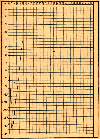
|
Fig. 44. Chart with moveable scale on which graphically
to record the weight of an infant.
|
|
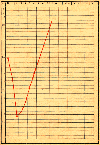
|
Fig. 45. Normal curve of an infant's weight during the
first ten days of life.
|
|
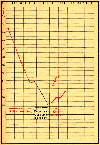
|
Fig. 46. Curve of an infant showing great loss of weight,
due to under-feeding. The total supply of mother and
wet-nurse was insufficient.
|
|
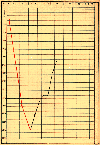
|
Fig. 47. Mother unwilling to suckle. Result of constant
supervision from the fifth day.
|
|
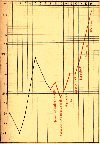
|
Fig. 48. Mother who did not wish to nurse. Effect of
intermittent supervision.
|
|
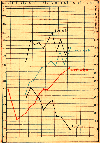
|
Fig. 49. Maternal feeding inadequate at first. Mother's
efforts temporarily aided by asses' milk. Red, infant's
weight; blue, mother's milk; black, asses' milk. Interrupted
black line, total of the two milks.
|
|

|
Fig. 50. Maternal milk did not appear till between the
fifth and sixth days. Sterilised cows' milk was used first
as a substitute, then as a supplement.
|
|
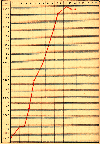
|
Fig. 51. Infant who took too much milk. His weight
increased considerably, but he had digestive troubles.
|
|
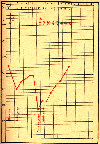
|
Fig. 52. Digestive troubles and loss of weight due to
feeding at irregular intervals. The infant recovered, and
began to thrive when the feeding was rigorously regulated.
|
|
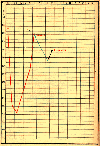
|
Fig. 53. Mother had mastitis, infant lost weight.
|
|
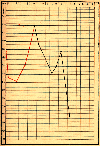
|
Fig. 54. Coryza. Loss of weight owing to interference
with sucking.
|
|
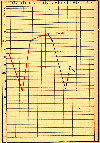
|
Fig. 55. "Thrush" (muguet). Loss of weight owing
to the pain of sucking.
|
|
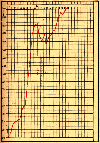
|
Fig. 56. Weight increasing in the presence of
broncho-pneumonia.
|
|
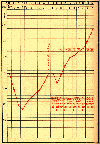
|
Fig. 57. Persistent increase of weight during the course
of an inflammatory process around the umbilicus.
|
|
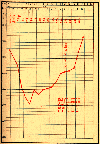
|
Fig. 58. Weight curve of an infant who died of
erysipelas. Considerable rise in the last two days of life.
|
|

|
Fig. 59. Weight curve of a dying infant, showing increase
of 250 grams in the last twenty-four hours of life.
|
Return to The Nursling Contents Page
Created 2/9/97 / Last modified 2/9/97
Copyright © 1998 Neonatology on the Web / webmaster@neonatology.net















